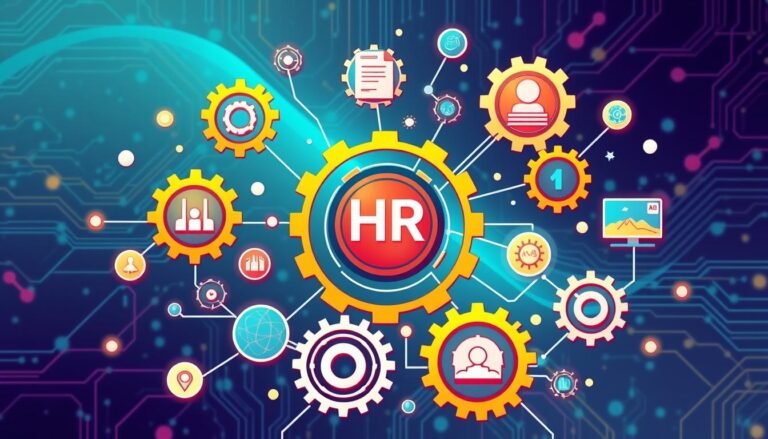Employee Recognition and Motivation Techniques
In today’s fast-paced business world, showing appreciation to employees is key. Companies are now using rewards and incentives to manage performance. These methods not only make employees happier but also make them more productive and creative.
When employees feel valued, they are more satisfied with their jobs. This leads to a better work environment. By having formal recognition programs and clear goals, companies can push their teams to do their best. This benefits both the employees and the company’s success.
Investing in employee growth through mentorship and training boosts motivation and job happiness. This helps staff take on new tasks, helping both them and the company. A supportive work environment is essential for keeping employees engaged and creative.
Key Takeaways
- Recognition programs boost employee morale and productivity
- Clear goal-setting provides direction and purpose
- Professional development opportunities enhance motivation
- Positive work environments foster creativity and innovation
- Motivated employees contribute to higher profitability
- Work-life balance initiatives improve overall job satisfaction
Importance of Employee Recognition in the Workplace
Employee recognition is key in building a great workplace culture. It boosts employee engagement and brings many benefits to both workers and companies.
Enhancing Employee Morale
Recognition makes employees feel valued, which boosts their morale. A simple ‘thank you’ from a manager can make employees work harder. In fact, a study showed that saying ‘thank you’ can make employees try harder by 69%.
Boosting Job Satisfaction
When employees are recognized, they’re happier at work. Many workers say they’d do better work if they felt more appreciated. They also describe their workplaces as places with “excellent integrity” and “uplifting environments.”
Reducing Turnover Rates
Recognition helps keep employees from leaving. Companies with recognition programs see 31% less turnover than those without. This is crucial since nearly 52% of new hires think about leaving within three months.
| Impact of Recognition | Increase in Likelihood |
|---|---|
| Perceiving promotions as fair | 2.6 times |
| Driving innovation | 2.2 times |
| Going above and beyond duties | 2.0 times |
By focusing on employee recognition, companies can build a positive work culture. This culture encourages engagement, satisfaction, and loyalty among employees.
Different Types of Employee Recognition Programs
Recognition programs are key to boosting morale and productivity in the workplace. Companies have many ways to thank their staff for their hard work and achievements. Let’s look at the main types of recognition programs and how they affect work life.
Formal Recognition Programs
Formal recognition programs are set up by companies to celebrate employee success. These include awards like “Employee of the Month,” bonuses for outstanding performance, and celebrations for years of service. Some companies even give out certificates for exceptional work.
| Formal Recognition Type | Description | Impact |
|---|---|---|
| Employee of the Month | Monthly award for exceptional performance | Boosts motivation and sets standards |
| Annual Bonuses | Monetary rewards tied to yearly performance | Encourages long-term dedication |
| Service Anniversaries | Celebration of employee loyalty | Promotes retention and company loyalty |
Informal Recognition Strategies
Informal recognition strategies are more flexible ways to show appreciation. They include spontaneous praise, team celebrations, and recognition from peers. Non-monetary rewards like extra vacation days or special projects also fall here. A survey found that recognition from managers has the biggest impact.
“Good bosses can raise productivity by up to 50%.”
Combining formal and informal recognition programs is the best way to appreciate employees. This mix ensures that both planned and spontaneous thanks are part of the company culture. It creates a positive work environment and boosts productivity.
Techniques for Effective Employee Motivation
Effective performance management and leadership strategies are key to motivating employees. By implementing the right techniques, organizations can boost engagement, productivity, and overall job satisfaction.
Setting Clear Goals
Setting clear and measurable goals is crucial for employee motivation. When employees know what’s expected of them, they feel focused and driven. Research shows that well-defined objectives can significantly increase motivation levels by providing a sense of progress and achievement.
Providing Constructive Feedback
Regular, constructive feedback is essential for employee growth and motivation. Performance management should include timely recognition tied to specific accomplishments. This approach not only acknowledges good work but also guides employees towards improvement.
“Recognition is the most impactful driver of great work.”
Effective leadership strategies involve understanding individual career aspirations. Managers who know their team members’ long-term goals can better align work assignments and development opportunities. This fosters loyalty and dedication.
| Motivation Technique | Impact on Engagement | Effect on Performance |
|---|---|---|
| Clear Goal Setting | 14% increase | Higher focus and efficiency |
| Constructive Feedback | 16x more engagement | Improved productivity |
| Recognition Programs | 4x higher engagement | Reduced burnout rates |
By implementing these techniques, organizations can create a motivated workforce. This workforce drives innovation and achieves outstanding results.
The Role of Leadership in Recognition
Leadership strategies are key in shaping workplace culture and boosting employee recognition. Good leaders know how important it is to show appreciation. This can really motivate and improve performance. In fact, 58% of employees say recognition from leaders makes them happier at work.
Leading by Example
Leaders set the example for recognition in a company. When leaders show real appreciation, it spreads throughout the organization. Research shows that regular recognition makes employees feel 5 times more valued. This can lead to better work and new ideas.
Encouraging Team Collaboration
Strong leadership builds a culture of teamwork and peer recognition. Programs that let employees recognize each other can increase engagement by up to 45%. This approach not only encourages good behavior but also strengthens team spirit and improves the workplace culture.
“Recognition is the fuel that powers great workplaces. When leaders make it a priority, they create an environment where employees thrive.”
To really make recognition work, leaders should:
- Give feedback that is consistent and timely
- Make recognition personal to each employee
- Use technology to make recognition easier
- Find the right balance between public and private recognition
By focusing on recognition, leaders can build a positive work culture. This culture drives success and keeps the best employees. Companies that really focus on recognition see a 26% increase in revenue per employee. This shows how effective leadership in recognition can pay off.
Social Recognition: A Growing Trend
Social recognition is changing how we work. It uses our love for social media and connecting with others. Companies are using these tools to make work better and more engaging.
Utilizing Social Media for Praise
Social media is a great way to praise employees. Millennials and Gen Z spend a lot of time online. Sharing work achievements online boosts pride and motivation.
It also helps attract the best talent. This is because it shows a workplace that values everyone’s contributions.
Implementing Peer Recognition Programs
Peer-to-peer recognition is key for team success. It lets coworkers thank each other for their hard work. Digital tools make this easy and affordable.
They improve motivation, productivity, and teamwork. Everyone feels more connected and valued.
| Impact of Social Recognition | Percentage |
|---|---|
| Increased profitability in engaged teams | 21% |
| Higher productivity in engaged teams | 17% |
| Employees who would work harder if appreciated | 69% |
Social recognition makes work better and more connected. It encourages everyone to celebrate company wins. By using these methods, companies can create a great work environment where everyone feels appreciated and motivated.
The Impact of Recognition on Employee Performance
Recognition is key in managing performance and keeping employees engaged. When workers feel appreciated, they work better and come up with new ideas. Let’s see how recognition changes the workplace.
Improving Productivity
Recognizing what employees do boosts their productivity. Research shows 80% of workers work harder when they’re recognized. This is because they feel more motivated and have a sense of purpose.
Companies with strong recognition programs see a 14% jump in engagement and performance. This leads to better customer loyalty and fewer employees leaving.
Driving Innovation
Recognition helps employees feel free to share their ideas. Those who are recognized often come up with 2.2 times more new solutions.
By praising both big and small achievements, companies encourage good behavior. This makes employees want to do more, creating a culture of growth and creativity.
| Recognition Impact | Percentage |
|---|---|
| Increase in profitability | 23% |
| Reduction in turnover | 51% |
| Decrease in absenteeism | 78% |
| Boost in customer loyalty | 10% |
Good recognition strategies unlock employee potential and help companies succeed. By focusing on recognition, companies can build a team that’s dedicated, creative, and works towards common goals.
Customizing Recognition Approaches for Your Team
Showing appreciation to employees is key to a great workplace culture. It’s important to make recognition fit your team’s needs and likes.
Understanding Individual Preferences
Everyone likes recognition in their own way. Some like being praised in front of others, while others prefer it to be private. Forbes Human Resources Council says that real and often recognition boosts happiness and job satisfaction.
One good idea is to recognize employees every week, not just once a month. This can make them more engaged.
Adapting to Diverse Work Environments
Today’s workplaces are different, so recognition must be flexible. Remote workers, for example, value quality time and direct praise. Using online tools, like virtual high-fives, can keep everyone motivated.
Adding recognition to daily tasks, like through chat, can make appreciation more consistent. It’s all about making it personal.
Custom e-cards or celebrating personal wins can really make a difference. Gallup found that praise from managers and top leaders means a lot. Recognizing specific actions motivates employees more than general praise.
“Recognition of behaviors that drive organizational values can create a culture of recognition and achievements.”
By knowing what each employee likes and adapting to different work settings, you can build a strong appreciation program. This will improve your workplace culture and make your team happier.
Technology in Employee Recognition
The digital age has changed how we recognize employee achievements. It has made tracking and boosting engagement easier. Now, tech solutions are key for a culture of appreciation.
Tools for Tracking Achievements
Today’s technology offers great tools for tracking employee success. Digital platforms allow for instant recognition. This boosts motivation and engagement.
Now, 72% of companies use tech for employee recognition. These tools range from simple apps to complex systems that work with performance software.
Benefits of Digital Recognition Platforms
Digital platforms offer many benefits for employee recognition:
- Real-time feedback: Employees get instant praise, which lifts their spirits.
- Data-driven insights: Companies can see trends and how recognition affects them.
- Accessibility: Mobile apps let employees be recognized anytime, anywhere.
- Personalization: Tech allows for rewards that fit each person’s preferences.
These platforms have a big impact. Companies using tech for recognition see a 58% jump in employee engagement.
| Metric | Impact of Tech-Based Recognition |
|---|---|
| Employee Engagement | 58% Improvement |
| Employee Turnover | 50% Decrease |
| Employee Productivity | 20% Increase |
By using technology, companies can make their recognition programs better. This not only makes employees happier but also helps the company succeed over time.
Incorporating Employee Feedback in Recognition Programs
Employee feedback is key to great recognition programs. It helps you create initiatives that really speak to your team. This boosts engagement and strengthens your workplace culture.
Surveys and Polls
Surveys and polls give you a straight shot at what employees think. They show what kinds of recognition they value most. Some companies have “Feedback Fridays” to highlight weekly achievements.
Exit Interviews
Exit interviews offer deep insights into your recognition programs. Leaving employees often share honest thoughts on what worked and what didn’t. This feedback helps improve your recognition strategy, possibly lowering turnover.
“Companies with well-crafted employee recognition programs see employees planning to stay with the organization four years longer compared to companies without such programs.”
Using employee feedback, you can make recognition programs that boost engagement and create a positive work environment. Studies show these programs can increase productivity by 14%. Tailoring your efforts to what employees want leads to happier, more loyal employees.
Celebrating Milestones and Achievements
It’s key to celebrate employee milestones and achievements to create a positive work space. Companies that value their employees see happier workers and less turnover. Let’s look at some ways to celebrate your team’s wins.
Work Anniversaries
Marking work anniversaries shows employees they’re important. It boosts morale and strengthens bonds at work. Here are some ideas for celebrating work milestones:
- Personalized gifts or experiences
- Public recognition in team meetings
- Extra time off
- Professional development opportunities
Project Completions
Celebrating when projects are done is key to motivating teams. It makes everyone feel accomplished and ready for more. Here are some rewards for finished projects:
- Team outings or celebrations
- Bonuses or monetary rewards
- Recognition in company-wide communications
- Opportunities for career advancement
Remember, 85% of professionals love daily thanks. By always recognizing achievements, you’ll build a culture of appreciation. This will boost engagement and productivity.
| Recognition Type | Impact on Employees | Company Benefits |
|---|---|---|
| Work Anniversaries | Increased job satisfaction | Lower turnover rates |
| Project Completions | Enhanced motivation | Improved productivity |
| Daily Appreciation | Feeling valued | Higher engagement |
Measuring the Effectiveness of Recognition Techniques
It’s key to track how well employee recognition works. This helps with managing performance and keeping employees happy. Companies use different tools to see if their recognition programs are working well.
Key Performance Indicators (KPIs)
KPIs give real numbers on how well recognition is doing. A good goal is to get 80% of employees to participate. This helps build a culture that values appreciation.
Watching turnover rates is also important. One company saw an 8% drop in just a year with a recognition program. Other key areas to watch include productivity, how often people call in sick, and how happy customers are.
Employee Engagement Surveys
Surveys are a great way to understand how recognition impacts job happiness. They help shape programs to what employees like, boosting morale and engagement. A Deloitte study showed that good recognition programs can raise employee engagement and productivity by 14%.
Using this data helps companies make better choices. This leads to better retention and a better work environment.
Source Links
- 5 Effective Employee Motivation Techniques | Candor
- 15 Effective employee motivation techniques to try in 2024 for greater success
- Employee Motivation Ideas | Reward Gateway
- Creating a Culture of Recognition
- The Importance of Employee Recognition — With Tips – The Connors Group
- Blog | Types of Employee Recognition: The Who, What, When, Where and Why – Nectar
- 20 employee recognition ideas that work | Culture Amp
- An HR Guide on Employee Recognition Programs | Rippling
- How to Motivate Employees: 9 Helpful Tips
- Employee Engagement – Employee Motivation : 20 Easy Ways to Motivate Your Coworkers & Employees
- How Leadership Fosters a Culture of Recognition | Assembly
- The Role of Leadership in Employee Recognition I Management & Leaderiship
- Amplify Employee Success with Social Recognition
- What Is Social Recognition & Why Should Organizations Give it Importance?
- Social Recognition as a Multiplier for Employee Recognition?
- The Importance of Employee Recognition: Low Cost, High Impact
- How Recognition Affects Employee Performance and Engagement
- How Recognition Affects Employee Motivation – PeopleThriver
- Council Post: 16 Effective Ways To Incorporate Employee Recognition For Enhanced Motivation
- Best Creative Ideas to Recognize Your Workforce | Assembly
- Recognition and Reward Programs: Improving Through Technology
- No title found
- Your Complete Guide to Employee Recognition Programs
- 10+ Employee Recognition Program Ideas
- 10 Steps to Build an Effective Employee Recognition Program
- 40 Impactful Employee Recognition and Appreciation Ideas
- Work Anniversaries & Milestones Best Practices | Assembly
- Celebrating Success: The Power of Recognition and Growth in the Workplace
- How to Measure Employee Recognition: Driving Success Through Data
- How to Measure the Success of Employee Recognition Software
- Measuring the ROI of Employee Recognition and Its Impact on Revenue – Sparkfolios








